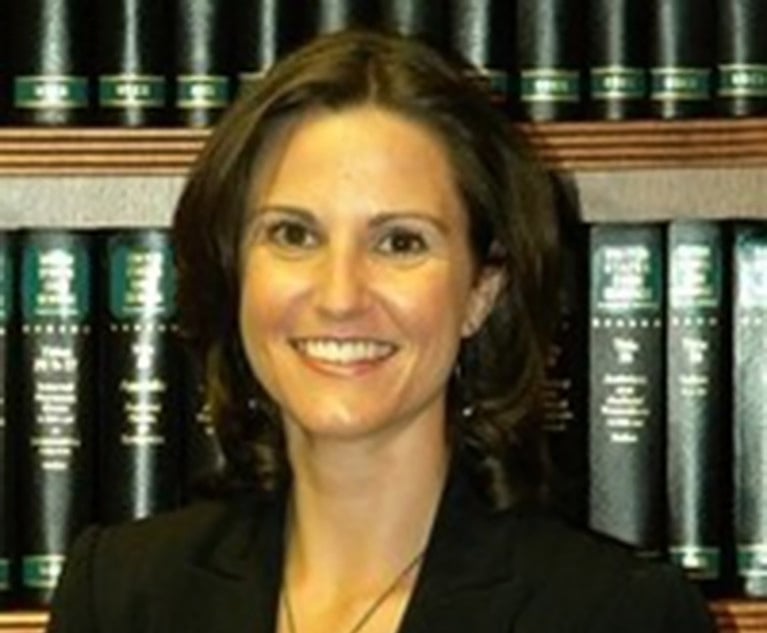To Be, or Not To Be … Laches
In view of the myriad ways lawyers misstate, misplace or, in some cases, mistakenly weaponize the doctrine of laches, a revisit and clarification of the doctrine is worthwhile.
April 03, 2020 at 02:30 PM
8 minute read
 In delay, there lies no plenty.
In delay, there lies no plenty.
— William Shakespeare, Twelfth Night. Act 2, Scene 3
When I see a bird that walks like a duck and swims like a duck and quacks like a duck, I call that bird a duck.
— James Whitcomb Riley (1849-1916)
It wasn't until speaking to experienced opposing counsel on a breach of contract claim my client brought within the six-year limitations period (albeit 4½ years after the breach) that it dawned on me how little even experienced practitioners understand the doctrine of laches. "Your client sat on his rights, waiting nearly five years to bring this action and doing absolutely nothing to prosecute his claim; no court will allow it to go forward," he argued. Some less experienced litigators may not have yet encountered some version of the creative—and incorrect—pronouncements of the law my adversary posited in defense of claims or negotiating settlements. However, as my experienced adversary's comment showed, laches, which gets thrown into the affirmative defenses mix without meaningful regard to the claims alleged, seems to be misunderstood by newbies and longtime litigators alike. In view of the myriad ways lawyers misstate, misplace or, in some cases, mistakenly weaponize the doctrine of laches, a revisit and clarification of the doctrine is worthwhile.
Elements and Applicability as an Equitable Defense
Laches is an equitable affirmative defense that requires "a lengthy neglect or omission to assert a right and the resulting prejudice to an adverse party … . [but] [t]he mere lapse of time, without a showing of prejudice, will not sustain a defense of laches." Saratoga Cty. Chamber of Commerce v. Pataki, 100 N.Y.2d 801, 816 (2003) (citations omitted). As such, in order to successfully bar a claim based on laches, "a party must show: (1) conduct by an offending party giving rise to the situation complained of, (2) delay by the complainant in asserting his or her claim for relief despite the opportunity to do so, (3) lack of knowledge or notice on the part of the offending party that the complainant would assert his or her claim for relief, and (4) injury or prejudice to the offending party in the event that relief is accorded the complainant.'" Kverel v. Silverman, 172 A.D.3d 1345, 1348 (N.Y. App. Div.), leave to appeal denied, 34 N.Y.3d 904 (2019). Moreover, "[p]rejudice may be demonstrated 'by a showing of injury, change of position, loss of evidence, or some other disadvantage resulting from the delay.'" Diecidue v. Russo, 142 A.D.3d 686, 688 (N.Y. App. Div. 2016) (citations omitted).
Some of us probably recall learning in civil procedure class that laches, though seemingly like a statute of limitation, is actually an equitable defense that applies as a bar to equitable claims, and equitable claims only. Indeed, courts and commentators alike have long recognized that laches is not a statutory limitation, but rather is "a centuries-old system of English jurisprudence in which judges based decisions on general principles of fairness in situations where rigid application of common-law rules would have brought about injustice." See Federal Judicial Center, History of the Federal Judiciary: Federal Rules of Civil Procedure Merge Equity and Common Law.
As such, laches should be thought of as the courts' articulation of the axiom "justice delayed is justice denied," but only where no limitations period is prescribed, as was recognized in a recent U.S. Supreme Court decision. In that case, the question before the High Court was whether laches barred certain "rolling" copyright infringement claims, despite the claims having been brought within the statutory limitations period. In holding that laches did not apply, especially as to infringement claims that fall within the 3 year limitations period, the court noted that "laches is a defense developed by courts of equity; its principal application was, and remains, to claims of an equitable cast for which the Legislature has provided no fixed time limitation … ." Petrella v. Metro-Goldwyn-Mayer, 572 U.S. 663, 678 (2014) (citations omitted).
Laches is therefore inapplicable to actions seeking non-equitable relief, such as the earlier mentioned contract case in which my adversary incorrectly invoked the doctrine. See, e.g., Ranney v. Tonawanda City Sch. Dist., 160 A.D.3d 1461, 1462 (N.Y. App. Div. 2018) (citing Makarchuk v. Makarchuk, 59 A.D.3d 1094, 1095 (2009) and Pittsford Canalside Properties v. Pittsford Vill. Green, 154 A.D.3d 1303, 1303-05 (N.Y. App. Div. 2017). Thus, like the right to a jury trial, whether laches is an available remedy hinges on whether plaintiffs' claims are equitable or legal in nature. See Canandaigua Emergency Squad v. Rochester Area Health Maint. Org., 130 A.D.3d 1530, 1531 (N.Y. App. Div. 2015).
Indeed, it is the nature of laches as an equitable remedy, i.e., non-statutory, non-legal, and non-jury, that distinguishes it from its cousin—statutes of limitation—as specifically enumerated in N.Y. C.P.L.R. §§213, 214, 215, 217 (McKinney) and other non-CPLR limitation periods. Consequently, though counsel's proclamation that a plaintiff "sat on his rights" may sound superficially plausible with regard to defense of a legal claim, it is the quintessence of an empty threat.
Laches in the Context of Mixed Nature Actions
What of a claim that does not, from its face, clearly appear as an action at law or in equity? (It should be noted that, due to the 1938 merger of equity and common law under the Rules Enabling Act of 1934, which enacted a uniform set of rules of procedure for the federal courts, e.g., the Federal Rules of Civil Procedure, federal courts no longer drew distinctions between claims in equity or law, and treated such suits together under the term "civil action." Id.) Take, for example, the declaratory judgment action. An action for declaratory relief does not seek damages (the hallmark characteristic of a legal claim). But, it also does not ask the court to compel the defendant "do" anything in particular either, as would be in the nature of most equitable claims. As to the latter, the following aptly illustrates this dilemma:
[T]he declaratory judgment lacks the distinctive characteristics of the equitable remedies. That is, when a plaintiff seeks a declaratory judgment, the general rule is that none of the following apply: the adequacy requirement, the equitable ripeness requirement, the specificity requirement, the greater degree of choice in achieving the plaintiff's rightful position, administration of the remedy by masters and receivers, ex post revision, and contempt.
Samuel L. Bray, The System of Equitable Remedies, 63 UCLA L. Rev. 530, 561 (2016).
Fortunately for New York practitioners, the Court of Appeals provides specific guidance in response to this dilemma. Rather than resorting to a bright line rule stating that the absence of any demand for damages necessarily means that an action for declaratory relief is, by definition, equitable in nature, resolution will instead depend on "the nature of the relief sought—i.e., declaratory as distinguished from coercive—rather than its substance, which gives the action its identity." Solnick v. Whalen, 49 N.Y.2d 224, 229 (1980). As such, "if the action for a declaratory judgment could have been brought in a different form asserting a particular cause of action, the limitations period applicable to the particular cause of action will apply." Schulman v. Schulman, 166 A.D.3d 833, 834 (N.Y. App. Div. 2018). Notably, the court further clarified that although declaratory judgment actions do not have specific limitations statute ascribed to them, they are nonetheless not subject to the "catch-all" provision of N.Y. C.P.L.R. §213(1) (McKinney).
Nor is it insignificant by comparison that, in the wake of the Schulman decision, many New York courts have gone on to also allow a trial by jury for those declaratory judgment actions premised upon an action at law, i.e., "traditional actions [that] would most likely have been used to present [a] claim had the declaratory judgment action not been created." See State Farm Mut. Auto. Ins. Co. v. Sparacio, 25 A.D.3d 777, 778-79 (2006). See also Margesson v. Bank of New York, 291 A.D.2d 694, 698 (2002), amended on reargument, No. 90382, 2002 WL 1289474 (N.Y. App. Div. June 10, 2002) ("consolidation of equitable and legal actions will not divest a right to a jury trial on the legal claim"); but see Anesthesia Assocs. of Mount Kisco v. N. Westchester Hosp. Ctr., 59 A.D.3d 481, 482 (2009) ("Once the right to a jury trial has been intentionally lost by joining legal and equitable claims, any subsequent dismissal, settlement or withdrawal of the equitable claim(s) will not revive the right to trial by jury").
Renier P. Pierantoni is a partner at Cooper, LLC.
This content has been archived. It is available through our partners, LexisNexis® and Bloomberg Law.
To view this content, please continue to their sites.
Not a Lexis Subscriber?
Subscribe Now
Not a Bloomberg Law Subscriber?
Subscribe Now
NOT FOR REPRINT
© 2025 ALM Global, LLC, All Rights Reserved. Request academic re-use from www.copyright.com. All other uses, submit a request to [email protected]. For more information visit Asset & Logo Licensing.
You Might Like
View All


Trending Stories
- 1Big Law Firms Sheppard Mullin, Morgan Lewis and Baker Botts Add Partners in Houston
- 2Lack of Jurisdiction Dooms Child Sex Abuse Claim Against Archdiocese of Philadelphia, says NJ Supreme Court
- 3DC Lawsuits Seek to Prevent Mass Firings and Public Naming of FBI Agents
- 4Growth of California Firms Exceeded Expectations, Survey of Managing Partners Says
- 5Blank Rome Adds Life Sciences Trio From Reed Smith
Who Got The Work
J. Brugh Lower of Gibbons has entered an appearance for industrial equipment supplier Devco Corporation in a pending trademark infringement lawsuit. The suit, accusing the defendant of selling knock-off Graco products, was filed Dec. 18 in New Jersey District Court by Rivkin Radler on behalf of Graco Inc. and Graco Minnesota. The case, assigned to U.S. District Judge Zahid N. Quraishi, is 3:24-cv-11294, Graco Inc. et al v. Devco Corporation.
Who Got The Work
Rebecca Maller-Stein and Kent A. Yalowitz of Arnold & Porter Kaye Scholer have entered their appearances for Hanaco Venture Capital and its executives, Lior Prosor and David Frankel, in a pending securities lawsuit. The action, filed on Dec. 24 in New York Southern District Court by Zell, Aron & Co. on behalf of Goldeneye Advisors, accuses the defendants of negligently and fraudulently managing the plaintiff's $1 million investment. The case, assigned to U.S. District Judge Vernon S. Broderick, is 1:24-cv-09918, Goldeneye Advisors, LLC v. Hanaco Venture Capital, Ltd. et al.
Who Got The Work
Attorneys from A&O Shearman has stepped in as defense counsel for Toronto-Dominion Bank and other defendants in a pending securities class action. The suit, filed Dec. 11 in New York Southern District Court by Bleichmar Fonti & Auld, accuses the defendants of concealing the bank's 'pervasive' deficiencies in regards to its compliance with the Bank Secrecy Act and the quality of its anti-money laundering controls. The case, assigned to U.S. District Judge Arun Subramanian, is 1:24-cv-09445, Gonzalez v. The Toronto-Dominion Bank et al.
Who Got The Work
Crown Castle International, a Pennsylvania company providing shared communications infrastructure, has turned to Luke D. Wolf of Gordon Rees Scully Mansukhani to fend off a pending breach-of-contract lawsuit. The court action, filed Nov. 25 in Michigan Eastern District Court by Hooper Hathaway PC on behalf of The Town Residences LLC, accuses Crown Castle of failing to transfer approximately $30,000 in utility payments from T-Mobile in breach of a roof-top lease and assignment agreement. The case, assigned to U.S. District Judge Susan K. Declercq, is 2:24-cv-13131, The Town Residences LLC v. T-Mobile US, Inc. et al.
Who Got The Work
Wilfred P. Coronato and Daniel M. Schwartz of McCarter & English have stepped in as defense counsel to Electrolux Home Products Inc. in a pending product liability lawsuit. The court action, filed Nov. 26 in New York Eastern District Court by Poulos Lopiccolo PC and Nagel Rice LLP on behalf of David Stern, alleges that the defendant's refrigerators’ drawers and shelving repeatedly break and fall apart within months after purchase. The case, assigned to U.S. District Judge Joan M. Azrack, is 2:24-cv-08204, Stern v. Electrolux Home Products, Inc.
Featured Firms
Law Offices of Gary Martin Hays & Associates, P.C.
(470) 294-1674
Law Offices of Mark E. Salomone
(857) 444-6468
Smith & Hassler
(713) 739-1250







